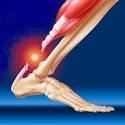Achilles Tendon Rupture
The Achilles tendon is the largest and strongest tendon in the body. It connects the calf muscle to the heel. It is placed under stress with every step we take and must withstand stresses of many times body weight when we run, push-off or jump.
This refers to a tear of all fibres of the Achilles tendon. The Achilles tendon is the largest and strongest tendon in the body. It connects the calf muscle to the heel. It is placed under stress with every step we take and must withstand stresses of many times body weight when we run, push-off or jump. It is prone to degenerative changes which weaken it, and these can leave the tendon prone to tearing completely (or rupturing).
Achilles tendon ruptures are most common in people over the age of 40 but can occur in younger people participating in high intensity sports. The tendon will usually rupture through the mid-portion of the tendon.
Risk Factors
- Genetic predisposition (collagen weakness) • Diabetes • High body weight • High body fat percentage
- Age
Diagnosis
The diagnosis is usually made from the history and from clinical testing. Further investigations such as x-ray, MRI and ultrasound can be undertaken to confirm the diagnosis and to assess other structures.
Treatment
Treatment of the ruptured tendon is dependent on the opinion of an orthopaedic surgeon.
- Non-Surgical – This involves immobilization of the area with a cast.
- Surgical – This involves suturing the ends of the tendon back together followed by a period of immobilization.
Following either of these options a thorough strengthening program will be set up to help restore full lower limb function. This should be designed and guided by a Physiotherapist.
Recovery Time
Recovery time for this conditon is varible but most can regain full function within 6 – 12 months.

